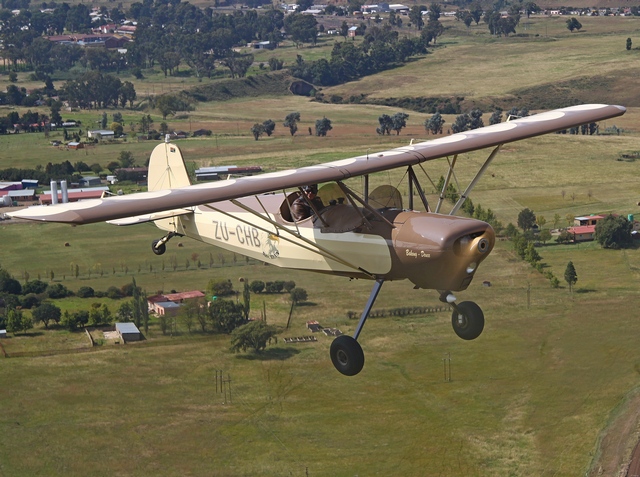The Bakeng Duce - Jerry Bakeng's Parasol Wing Beauty
By Willie Bodenstein
Looking at the Bakeng Duce one would not think that she has some connection with Boeing but this little parasol wing beauty has. She was designed and built in a mere six months and for the princely sum of $1500 by Jerry Bakeng, a well-known aeronautical engineer employed by Boeing. When she was first displayed at Airventure at Oshkosh in 1971 she was awarded the most Outstanding Design Trophy.

When one first see the tail wheel Duce with its tandem open cockpits and strut-braced parasol wing one can easily be mistaken for thinking that this is an aircraft of the thirties, the golden age of aviation when cockpits were open and low wings were a rarity and considered to be unsafe. She was however born in 1970 when the jet age was well established and mass produced Kit Planes were flooding the market. Available as a plan built, the Duce was an instant success with over two hundred sets of plans sold in the first nine years.

In 1999 the rights to the design was acquired by the Bakeng Deuce Airplane Factory who changed the spelling of its name to Deuce. The fuselage of the Deuce is of welded metal steel tube with the forward part of the fuselage skinned in metal, the rest in fabric. The spars and ribs of the wings are of wooden construction and are covered in fabric and are removable for easy transport and storage.

The Deuce seats two in tandem with the pilot flying from the rear seat. It has a useful load of 272 kg and maximum take off weight of 748 kg. Powered by the Lycoming 0-290 of 125 hp that needs to be hand started, she climbs at 1,000 feet per minute, has a maximum speed of 140 mph, cruise at 90 mph and has a service ceiling of 12,000 feet. At 6.33m long, the Deuce stands 2.13 m high and is smaller than the Tiger Moth although its wingspan of 9.25 m is .310 m longer than the Tiger's. She carries 50 litre of fuel in a header thank and a further 50 litres in the wings which she burns at about 18 to 24 litres per hour.

Fitted with the 125 hp Lycoming the taildragger Deuce will lift its tail at about 50 mph and at 65 mph and 400 feet will leave the runway. Stalls which occur at 60 mph with flaps and are almost a non event, the controls, as expected will get a bit mushy and there may be a small wing drop, relaxing the pressure on the stick with a little rudder is enough to get her back on even keel. Like all Taildraggers flown from the rear seat, visibility is somewhat restricted and on finals a slightly wide approach with the edge of runway to the left of the nose is advisable.

I first saw ZU-CHB at Petit on the East Rand where she was based for a number of years and I always had to be content with admiring her in the darkness of her hangar. Then she disappeared and I was told that she was bought by Henri Westermann and moved to his hangar at Witbank. In 2010 during the Ultimate Air Race I met Henri and he invited me to his hangar where she stood sharing space with his Jabiru, Glasair 3 and other toys. Henri readily agreed to a photo shoot but it was only in March 2011 when he flew her to the EAA Fly in and Airshow at Volksrus that the opportunity finally arrived. Johnny Smith kindly agreed to fly in the chase plane in his immaculate Super Cruiser and with Henri formatting on us, me furiously clicking away; we could pretend to be back in the skies over wartime Europe in the 30's.
|
    |























